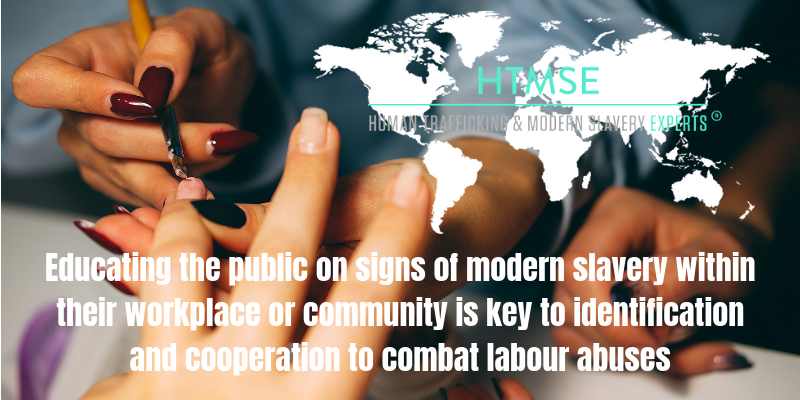
Along with the progress seen in the UK’s legislative framework around human trafficking and modern slavery, there is growing public awareness of the issue. In order for the justice system to work effectively to intercept traffickers, there is demand for the public to be educated on signs of labour abuse, and to work with authorities to report it.
A ground breaking case in January this year led to two traffickers jailed under the Modern Slavery Act for involvement in the trafficking of teenage girls from Vietnam to work unpaid in nail bars in Bath, UK. The importance of this case highlights how victims of slavery can fit into society so blatantly that many people who witness it, do not question the criminality behind it.
UK authorities such as the GLAA have composed toolsets for public education around the identification of modern slavery. Spot the Signs guidance provides clear explanations of human trafficking, forced labour, debt bondage and outlines specific types of exploitation to be aware of, including labour exploitation, sexual exploitation, domestic servitude, organ harvesting and criminal exploitation. The industries regulated by GLAA for forced labour are agriculture, food processing and packaging, construction, warehousing and logistics, service industry and catering, sweatshop manufacturing. As HTMSE have previously noted, there is an ever growing number of target industries for traffickers, including recently recycling and waste processing, football and sports, the beauty and massage industry, as well as a notorious market for forced criminality in cannabis growing operations.
Although each case of labour exploitation will have a variety of variables and indicators, as seen in the Bath case, young, foreign girls who seem fearful or ‘controlled’, and a have language barrier whereby their traffickers can take advantage of them, are potential victims. The GLAA outlines the most common indicators of labour exploitation. In addition to the victim’s characteristics and behaviour, signs to look out for in a victim’s situation are
- Restricted freedom, such as having no passport or ID
- Questionable working contract
- Poor working conditions
- Compromised finances
- Appearance indicating physical abuse or neglect
Unfortunately, once a potential victim is identified, it is not a simple process to restore their freedom. Due to the nature of their mental ‘conditioning’ by the traffickers, Stockholm Syndrome poses a major issue for authorities. If victims do not know they are being exploited or understand their situation, in many cases they are fearful of authorities and will resist cooperation. Spot the Signs highlights the irrelevance of the victim’s “consent” if they are “controlled by force, threats, coercion, abduction, fraud and deception” as it constitutes control over another person. For example, in the Bath case, one of the victims ran away from their foster home to their traffickers within days of release. This is where a victim centred approach, particularly in language services, is critical to consider right from the beginning in the identification of potential victims, and on going in order to ensure successful rehabilitation.
Although the public may not wish to become involved in a case, it is their civic duty if they witness or have suspicion of labour exploitation, to report it. In order to encourage the reporting of modern slavery suspicions, authorities should safeguard interests by maintaining anonymity and providing comprehensive, simple reporting methods. Educating the public on the signs of modern slavery within their workplace or community is key to identification and active public cooperation to combat labour abuses.